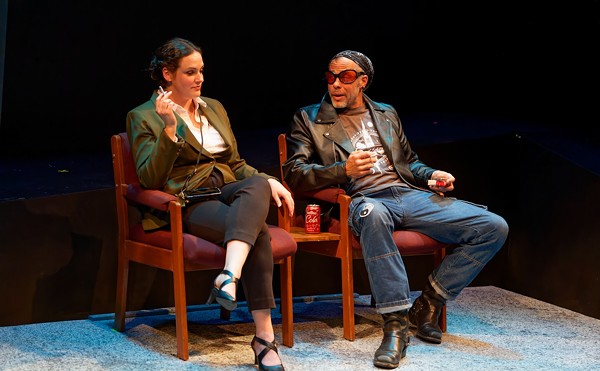"I wanted the title to be cryptic," playwright Thomas Gibbons explains without apology about Bee-luther-hatchee, which is being performed by the Repertory Theatre of St. Louis. So Gibbons sought out a dictionary of African-American slang and "went through it cover to cover" in search of a phrase he felt would capture the sense of mystery he hoped to convey in his script. He chose a phrase whose primary definition is "an absurd or ironic situation." But Gibbons selected the phrase for its secondary definition: "the next stop after hell." In his thoughtful treatise of a play, Gibbons is suggesting that racial politics in America has devolved into a kind of bee-luther-hatchee.
At its most literal, Bee-luther-hatchee is a play about words and about the myriad meanings behind words. Peter Hicks' imaginative scenic design -- a series of sliding panels -- is literally awash with words. For once, the set is not a backdrop to the action; this set is the action. Bee-luther-hatchee is forever probing both the raw power and the crippling limitation of words printed and spoken.
The bilevel set exposes the viewer to two wildly disparate worlds. The main stage focuses on Shelita Burns (Tamilla Woodard), an impassioned young African-American editor responsible for the publication of Bee-luther-hatchee, a memoir by an obscure old black woman named Libby Price, that has become a surprising bestseller. As a rising young Manhattan editor, Shelita is on the cusp of celebrity. She gives speeches at award banquets and is interviewed by the New York Times.
But who is Libby? Although Shelita has not yet met the elusive author, the audience comes to know her well, for on the balcony above the main stage the 72-year-old black woman recites excerpts from her eloquent memoir and enacts episodes from her life.
Act 1 is an accumulation of short scenes that chronicle Shelita's urgent attempts to find Libby. In stark contrast (but then, this entire play is defined by contrast), Act 2 is theater of discourse, an extended exchange between Shelita and a white stranger whom she has encountered in a hotel lobby. In debating themes of race and prejudice, they ponder such engrossing (if not resolvable) issues as the elasticity of art versus the hard truth of history and the tension that exists between cold fact and heated emotional truth. The point-counterpoint of their debates is punctuated by scenes that allow Libby to continue to tell her haunting story.
As the old woman who knows the torment of riding a lonely train into the depths of hell, Perri Gaffney's Libby is a marvel of clarity and simplicity. As she stands on the balcony, delivering speeches that often reach for stage poetry, Gaffney towers over the action both literally and figuratively. Her performance alone justifies the production. She receives subdued yet valuable support from Ron Bohmer as a white defender who offers Libby a temporary refuge from wandering.
But the Rep staging is thrown out of sync by Paul Niebanck's inexplicable portrayal of the young man who is at constant odds with Shelita. It's as if Niebanck's only direction was to watch TV reruns of Gomer Pyle. Dialogue is constantly hurled across the stage at cartoon decibel. Director Debra Wicks has mounted this play at least three times. Does she really believe that this in-your-face interpretation is what the playwright intended? Once again, the Rep has succeeded in miscasting a critical role.
Despite this misconceived performance, the evening succeeds, thanks to the substance of the play itself. This script -- which at its most ambitious is nothing less than a deconstruction of race relations -- has set for itself a huge task. Although some viewers may be frustrated by its refusal to offer clear-cut answers, at least Gibbons cannot be faulted for not having asked the questions. Bee-luther-hatchee is informed by the sincerity of conscience.
Among the many probing questions that Bee-luther-hatchee poses, one stands out: Why should an author be more important than the words he or she writes? Ironically, viewers are able to focus on the content in Gibbon' play in large measure because its playwright is so obscure. Most viewers won't even know the color of his skin, which lends a welcome impartiality to the arguments. (In fact, Gibbons is white.)
How, then, to approach Lebensraum, the newest effort by Israel Horovitz, who has been a well-known playwright since he burst onto the off-Broadway scene in 1968? If nothing else Horovitz has written in the past 35 years has been as striking as his first play, The Indian Wants the Bronx (which introduced an explosive young actor named Al Pacino), it hasn't been for lack of trying. The prolific Horovitz is to playwriting what Joyce Carol Oates is to novels: He cranks them out with astonishing rapidity. In his introduction to Lebensraum, Horovitz avers that this is his best writing since '68 -- which may be true, but how much is that really saying?
Lebensraum is not drama; it's not comedy. It's a dream play, a fantasy as removed from reality as Peter Pan, although not as textured as Peter Pan and lacking that story's staying power.
Here's the premise: At the start of the 21st century (which, curiously enough, is right now, even though the play is set in the future) the chancellor of the German republic decides to re-establish a Jewish community in Germany. He extends a sweeping invitation to six million Jews. These understandably wary emigrants are to "be given citizenship and full privileges in this great nation. You will be German." The narrative then follows a half-dozen partakers, who arrive from America, Australia, France and Israel. The tale's vast canvas of characters also includes three generations of Germans, who respond to this abrupt intrusion in varying ways.
This is the kind of fantastic plot that, filled out to 600 pages of purple prose, used to make for intriguing reading in novels by Irving Wallace or Leon Uris. What Horovitz has done is adapt a novel to the stage -- without bothering to first write the novel. His script is merely the bare bones of what, in another genre, might have been a provocative tale.
Lebensraum shares the same kind of imperative that infuses Bee-luther-hatchee. If slavery is the original sin Americans are still trying to expiate, Germans are still living under the stark shadow of the Holocaust. But the two plays could not be more different in approach. Horovitz's saga is part polemic, part melodrama but mostly exposition. The story is a mile wide and an inch deep. For comic relief, it relies on gay Jews and fahrt jokes. The most thought-provoking thing about Lebensraum is to wonder how a play that deals with the most profound event of the twentieth century can be about so little.
Horovitz has chosen to tell his saga with three actors playing more than 40 roles. This virtuoso display of performance-by-accent is intended to dazzle the audience. But the ploy backfires. After the opening night of the current New Jewish Theatre production, audience members were singing the praises of the versatile actors (Josh Bywater, Carrie Hegdahl, Jeremy Sher). But no one was discussing the play.
At intermission, a few folks also were asking about the meaning of the title. Almost as an afterthought, Horovitz introduces the word in the play's final minute, as Lebensraum is rushing to its conclusion. It's German for "living space." Nice as it is to know what a title means, by that point in the evening it didn't much matter.





